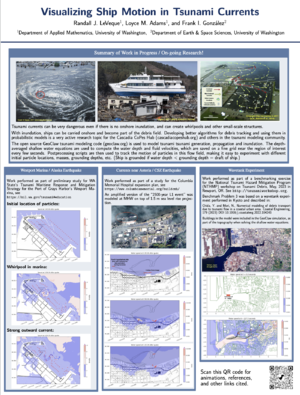2024 CSDMS meeting-012
From CSDMS
(if you haven't already)
"WA" is not in the list (NO STATE, Alabama, Alaska, Arizona, Arkansas, California, Colorado, Connecticut, D.C., Delaware, ...) of allowed values for the "CSDMS meeting state" property.
Log in (or create account for non-CSDMS members)
Forgot username? Search or email:CSDMSweb@colorado.edu
Browse abstracts
Visualizing Ship Motion in Tsunami Currents
Randall LeVeque,
(he/him),University of Washington Seattle , United States. rjl@uw.edu
Loyce Adams, University of Washington Seattle Washington, United States. lma3@uw.edu
Frank Gonzalez, University of Washington Seattle Washington, United States. figonzal@uw.edu
Tsunami currents can be very dangerous even if there is no onshore inundation, and can create whirlpools and other small-scale structures. With inundation, ships can be carried onshore and become part of the debris field. In this work, the open source GeoClaw tsunami modeling code (www.geoclaw.org) is used to model tsunami tsunami generation, propagation and inundation. The depth-averaged shallow water equations are used to compute the water depth and fluid velocities, which are saved on a fine grid near the region of interest every few seconds. Postprocessing scripts are then used to track the motion of particles in this flow field, making it easy to experiment with different initial particle locations, masses, grounding depths, etc. Developing better algorithms for debris tracking and using them in probabilistic models is a very active research topic for the Cascadia CoPes Hub (cascadiacopeshub.org) and others in the tsunami modeling community.

